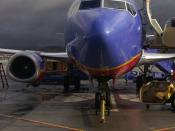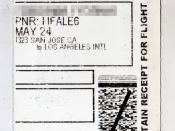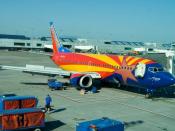Executive Summary
The strategy of Southwest Airlines (SWA) has remained the same, which is to give customers low-cost, point-to-point airfare, with excellent customer service. This simple strategy has resulted in SWA posting profits for 30 consecutive years. While other airlines are downsizing, SWA is showing slow steady growth. This performance is evident throughout their SEC Filings.
First we will look at SWA's ROI and ROE compared to the rest of the industry. Two thousand and one and 2002 were difficult years for the airline industry. Most airlines showed negative ROIs and ROEs, however SWA posted an average ROI of 16.76% for the three years ending in 2002. Likewise, they also showed a substantial 12.87% growth in ROE, during the same period.
The good news did not stop there. If we look at P/E Ratios, Southwest Airlines also out performed the industry. P/E Ratios give an indication of the amount over the market price, that investors would be willing to purchase the stock.
This has traditionally been a significant indicator for investors. SWA has shown numbers in the 29-46% percent range for the three-year period ending in 2002.
Two other economic indicators, which SWA exceeds the industry is dividend payout ratios, and dividend yields. With payout ratios of 2.7 to 18.1 and dividend yields of 0.44, Southwest Airlines should be at the top of the list for investors of airlines.
On top of all the excellent indicator information, SWA posted a $417,338,000 profits. How did they do this, when other airlines are losing money? SWA was posed with the burden of extra landing fees, security costs, and personnel cost; they were able to handle the costs through a few smart changes. They spent money to increase airport facilities, increase personnel, and increase technology. This led to an...


